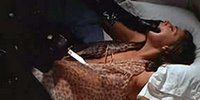
The film is all about fractured memories and fractured minds. All through the story, Sam is plagued by his memory of the attempted murder he witnessed. Something doesn’t seem right, and finding the fault line in his memory becomes Sam’s obsession, and the key to tracking the killer. Memory, and its unreliability and susceptibility to manipulation and deception, became a key theme in Argento’s films. His later masterwork, Deep Red, also featured a murder witness plagued by doubts of his own memories. Argento argues that we often remember in a way that our culture conditions us to remember. It’s only when the protagonist breaks through that conditioning and parses their memory from a fresh direction that they can solve the mystery.
The Bird with the Crystal Plumage has a stronger and leaner screenplay than most of Argento’s later works. The story’s focus is squarely on Sam’s investigation, with all needless clutter swept away. Predating CSI's fascination with forensics by three decades, the film delves into the use of technology to track down a murderer. This being the ’70s, said technology includes whirring magnetic tape reels and crude dot matrix printouts, but no matter. It’s still interesting to see an early meditation on the use of machines in detective work. In the end, though, wetware outperforms hardware, as Sam finally figures out what is missing from his memory, and the solution to the mystery and the reveal of the killer is ingenious and surprising.
Dario Argento’s direction is stylish and assured here, with a brilliant use of colour and darkness. One especially memorable shot shows the screen completely black other than a door to the left that shows as a white rectangle. The camera angles and the setup and movement of characters within the frame are carefully designed to imbrue the film with mounting dread. A sequence with the killer menacing Julia in her apartment by pecking a hole in the door with a large knife and peering through the hole at her is masterfully done. There are camera pyrotechnics on display here too, including a shot where a camera is dropped from a building on a cable to simulate the POV of someone falling. Unlike some of Argento’s later work, though, the direction is never intrusive and doesn’t overwhelm the film.

Argento is also helped considerably by legendary film music composer Ennio Morricone, whose haunting score adds another dimension to The Bird with the Crystal Plumage. The music is frequently dissonant, and the central melody includes a childlike chant, lending considerable edginess and eeriness to the film.
The Bird with the Crystal Plumage arrives for a second time on DVD in a 2-disc Special Edition from Blue Underground. This superb package includes a new remastered print on disc 1 that is a considerable improvement over the old DVD. Presented in its original 2.35:1 aspect ratio, the picture is vibrant and clear; for a ’70s film this is a showcase presentation. Disc 2 has several short documentary pieces on the film, including informative interviews with Argento and Morricone. This DVD set is well worth picking up for film buffs.

No comments:
Post a Comment